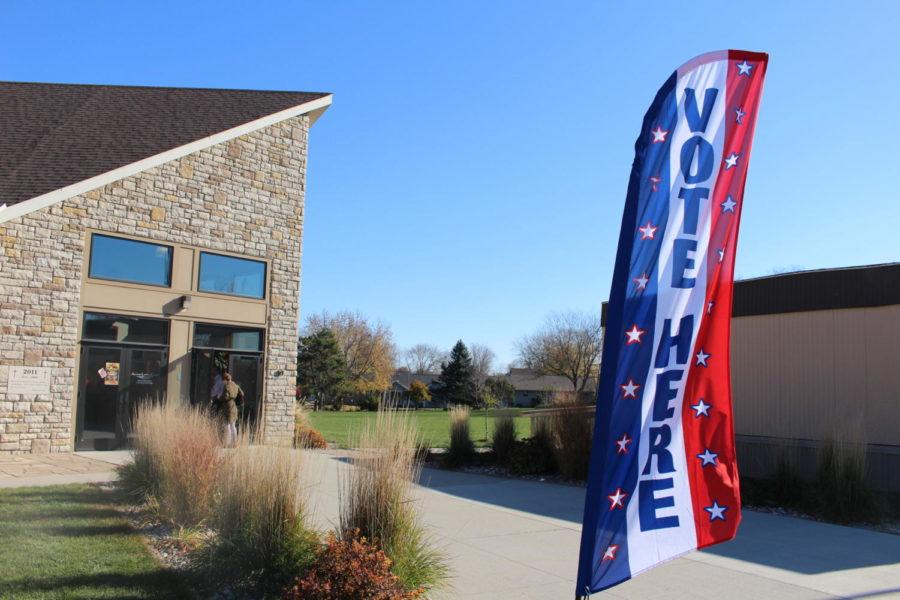Electoral reforms in the United States are changing the way votes count
A “Vote Here” sign waves in the wind in front of the Ascension Lutheran Church where Ames residents cast their ballot on Nov. 8, 2016.
November 5, 2019
Most elections in the United States are winner-take-all.
The concept of “winner-take-all” is also known as “first-past-the-post.” In this election process voters indicate on a ballot which candidate they would prefer win the election. In this process’ purest form, the candidate with the most votes — no matter how small a percentage of the total that is — would be elected to that position.
This is the election process used not only in most elections in the U.S. but also in Canada, the United Kingdom and several other democracies with origins in the British Empire. Other countries including Germany and Israel use systems of proportional representation for their election processes. The purest form of proportional representation is supposed do what its name implies: represent the voting population proportionally.
Mack Shelley, professor and chair of the political science department, said it is supposed to be a closer representation of what voters want to see from their elected officials, but this is not always the case.
“When you have this pure [proportional representation] system, which actually no one has a pure [system], you would get pretty much exactly the proportional representation in the national legislature that reflects voter preference, that is different from first-past-the-post,” Shelley said.
Germany has a representation threshold of 5 percent, Shelley said. This means if a party does not achieve at least 5 percent of the votes in the national election those votes can become wasted votes and the party will receive zero seats in the legislature. Thresholds like this are why no country has a pure form of proportional representation, just as the U.S. does not have a pure form of first-past-the-post voting.
It is common in first-past-the-post systems for elections to be centered around geography, resulting in gerrymandering and further skewing results from representing the popular vote.
“If you try hard enough you can influence and rig any kind of political system, whoever and whatever makes the rules pretty much determines the outcome,” Shelley said.
There have been reforms in recent years in the U.S. to attempt to better represent voters’ preferences than first-past-the-post elections are capable of.
Beginning with the 2018 elections in Maine, voters rank their choices in elections in the state. Their second and third choices are added up should no candidate receive at least 50 percent of the vote in the first round of voting.
New York City voted on a similar measure Tuesday to approve or reject ranked choice voting for primary and special elections in the city. If New York voters approve the measure, it will become the largest jurisdiction by population in the U.S. to use a method other than first-past-the-post to conduct its elections starting in 2021.
Andrew Yang offered his support for the measure on the ballot in New York in a tweet Tuesday.
This style of election is used in countries including Ireland and Australia.
Nothing in the U.S. Constitution directly states how elections should be run, other than dictating it is up to the states to decide how to do so.
Maine is one of two states along with Nebraska that do not award the state’s popular vote winner all of their electors in the electoral college. Instead, electors are awarded based on not only the winner of the statewide popular vote, but also the winner of each congressional district. Through this method, Donald Trump was able to add an electoral vote to his electoral college total from Maine despite losing the statewide popular vote to Hillary Clinton.
Most Americans are aware the system for electing their president is not a purely national first-past-the-post election, though polling suggests most would prefer such a system to the currently used electoral college.
A coalition of state governments are currently in the process of working to circumvent the electoral college through the “National Popular Vote Interstate Compact.”
This compact has been adopted by 15 states, accounting for 36.4 percent of all electoral votes. Once adopted by enough states to account for a majority of electoral votes, the states’ party to the compact would award their electoral votes to the national popular vote winner – ensuring the popular vote winner would always win the presidency, according to the National Conference of State Legislatures.
The electoral college was designed by the founding fathers to not necessary elect the candidate the people want, Shelley said. This is supposed to act as a barrier to the average person and it was not designed by accident.
“It was implemented in the U.S. Constitution to provide something like the mechanism by which kings were selected in late medieval and early modern Europe,” Shelley said. “The idea was a council of elders […] would make a choice based on who would be the best person to run the country, not based on who the people really want to run the country.”







